Table of Contents
ToggleIntroduction
The first AMD761-based motherboard we'll review is the Abit KG7-RAID. Abit was one of the last of the major manufacturers to release a board featuring AMD's own DDR chipset. But it seems the longer development was worth it, as it is generally regarded as the finest entry among AMD 761 based motherboards.
It is also the only AMD761-board to offer 4 memory slots, providing the possibility to use the maximum supported amount of AMD's flagship chipset, which is 4 GB. All other manufacturers offered only two memory slots on their boards, with the exception being Gigabyte, which at least offered 3 DDR slots on their GA-7DXR(+).
The Abit KG7 is available in the following configurations:
- KG7-RAID:
Flagship model with four memory slots and a Highpoint RAID chipset, offering a total of four UDMA100 connectors
- KG7:
identical to the KG7-RAID, minus the Highpoint controller
- KG7-Lite:
Only two DDR slots, no Highpoint RAID controller
Gallery
Specifications and Features
Chipset:
- AMD 761 Northbridge
- VIA 686B Southbridge
CPU Support (with latest BIOS):
- Athlon Thunderbird (ALL)
- Duron Spitfire (ALL)
- Athlon XP Palomino (ALL)
- Athlon XP Thoroughbred (FSB266 models up to 2000+)
- Duron Morgan (ALL)
Memory Support:
- 4 DDR DIMM slots, up to 4 GB total, support for Registered ECC
Expansion Slots:
- 1x AGP slot (1,5 / 3,3V) up to 4x
- 6x PCI slots
Connectors (internal):
- 2x IDE (UDMA100)
- 2x IDE RAID (UDMA100)
- 1x Floppy
- 2x USB 1.1
- 4x 3-pin fan connectors total (1x CPU + 3x chassis)
Connectors (external):
- 2x PS/2
- 2x COM/RS-232
- 1x Parallel Port
- 2x USB 1.1
I consider the lack of an onboard audio solution as a plus, as I think far better solutions than the old onboard chipsets are readily available for little money. Very commonly recommended are the Creative Soundblaster Live! cards for example, which offer fantastic compatibility with our beloved old games and sound far better than any onboard solution of that era.
I also don't list (from a retro-gamers perspective) useless connectors and features like IR, Smartcard- or Wake-on-LAN connectors and so on.
Overclocking Features:
- Adjustable Multiplier (BIOS) from x5 - x13 + "Above x13"
- Adjustable FSB (BIOS) from 100 to 200 MHz in 1 MHz steps
- Adjustable VCore (BIOS) from 1,100 V to 1,850 V in 0,025 V steps
- DDR Voltage (BIOS) from 2,44 to 3,00 V (16 settings)
- I/O Voltage (BIOS) 3,50 V / 3,65 V
- Clock Divider (BIOS) (FSB / RAM / PCI) 4:4:1 and 3:3:1
Overall, the BIOS design is great, almost all important performance options are packed together within the Softmenu III section. Additionally, there are lots of memory and chipset settings in the Advanced BIOS settings to finetune your system. A huge plus is also, that almost every BIOS option is explained in the manual. And by "explained" I mean explained and not just a description of the default value and available options. The KG7-RAID is completely jumperless (apart from “Clear CMOS” and so on), which makes setting it up simple and “modern”.
Documentation, Downloads, Drivers
There are many manufacturers of the early socket A era, that do not exist anymore. Sadly Abit is also among them, as they closed doors by the end of 2008. Therefore it is not necessarily an easy task to obtain bios files, drivers and documentation, since you can't simply go to the manufacturer's website and download the required files.
There is a copy of the original website “www.abit.com.tw” which can be accessed via http://abit.ws, but some parts of the site do not work anymore and the downloads are also (mostly?) broken. Fortunately, the latest BIOS files can be obtained on this fantastic website: https://soggi.org/motherboards/abit.htm
There are also driver downloads for a huge share of old chips (network, storage, chipset, etc.) available on this part of the site: https://soggi.org/drivers/drivers.htm
In terms of documentation, there exist many websites that offer a huge amount of manuals.
Here is one of them, that I already used several times:
https://www.manualslib.com/brand/abit/motherboard.html
Alternatively, here is a FTP mirror of Abit's manuals: https://downloads.bl4ckb0x.de/ftp.abit.com.tw/pub/download/manual/
Please note, that not all manuals are available at any language there.
Regarding CPU support you can find the info here: https://www.cpu-upgrade.com/mb-ABIT/index.html
I already use this site for a long time and I always found the info to be very accurate. I cannot remember that I had a motherboard, that was not featured there. Great site.
To sum it up: using a motherboard of a manufacturer that is not around anymore might not be as straightforward as using an Asus or Gigabyte motherboard, for example. But, especially with an iconic brand like Abit, it is not an impossible thing to do.
Design & Layout
In my opinion, the Abit KG7-RAID looks great. It has got a very tidy look to it and the signature top-left position of the CPU socket, that most Abit socket A boards of that time have.
From a practical point of view, the layout is also very good. Is offers three usable 3-pin FAN connectors which are well placed for the usage of a front- and a rear fan, as well as a dual-fan CPU cooler or an aditional fan in the rear. The ATX connector is located on the top of the PCB, which lets you route the power cable away from the airflow.
The onboard IDE connectors are placed perfectly on the right edge of the PCB, just above the line of the AGP port. The additional IDE RAID ports, as well as the floppy connector, went all the way down to the lower right corner of the PCB. This can cause problems in terms of cable legth in larger cases, but since there are no other connectors below these, the ribbon cables can be routed down and then upwards behind the PCB to hide them nicely.

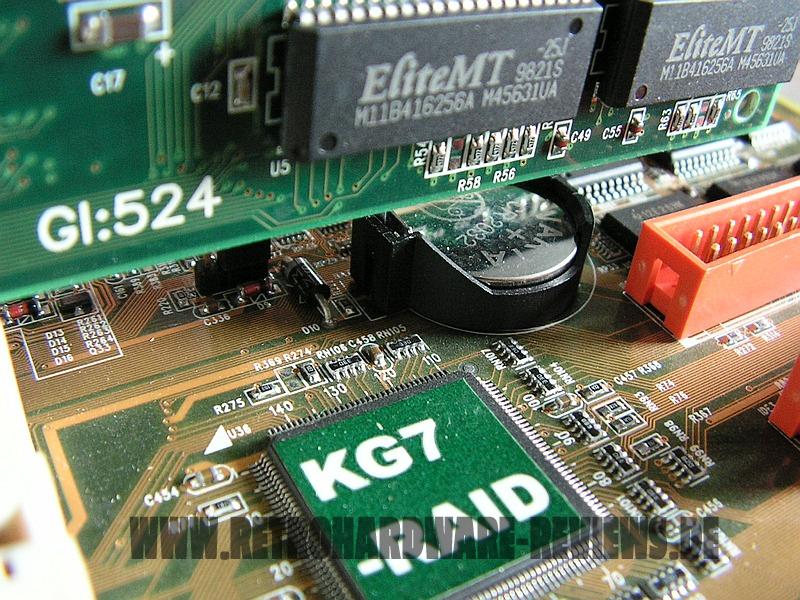
The position of the CMOS battery is a little to far towards the middleof the PCB, so that it might not be replaceable with larger PCI expansion cards installed, but I have seen far worse locations.
The aforementioned position of the CPU socket can be a little problematic with some CPU coolers like the Cooler Master HHC-001, as the socket is located very close to the top edge of the PCB. Quite some Cooler Master heatsinks (like the HHC-001) have a lever on the mounting bracket, that is supposed to help with the installation. But because the CPU socket is this close to the edge, the lever reaches a bit over the edge.
This makes it impossible to use such coolers on the KG7-RAID in cases where there is no (or very little) space between PSU and motherboard. Furthermore, you will have to take apart your entire system, if you want to install another CPU, apply new thermal paste or use another cooler. All other coolers should fit without issues however, even very large ones.
The big capacitors below the CPU socket are quite close though, and can make the installation of some coolers a bit difficult at times. When I recapped my KG7, I replaced them with poly caps, which are considerably smaller in height - this helps a lot.
I tested the following seven models towards compatibility on my KG7-RAID and except for the HHC-001, all of them fit without a problem:
- Thermaltake Silent Boost K7
- Cooler Master HHC-001
- Swiftech MCX 370
- Alpha PAL 6035
- Alpha PAL 8045
- Smartcooler 60mm
- Arctic Cooling Copper Lite
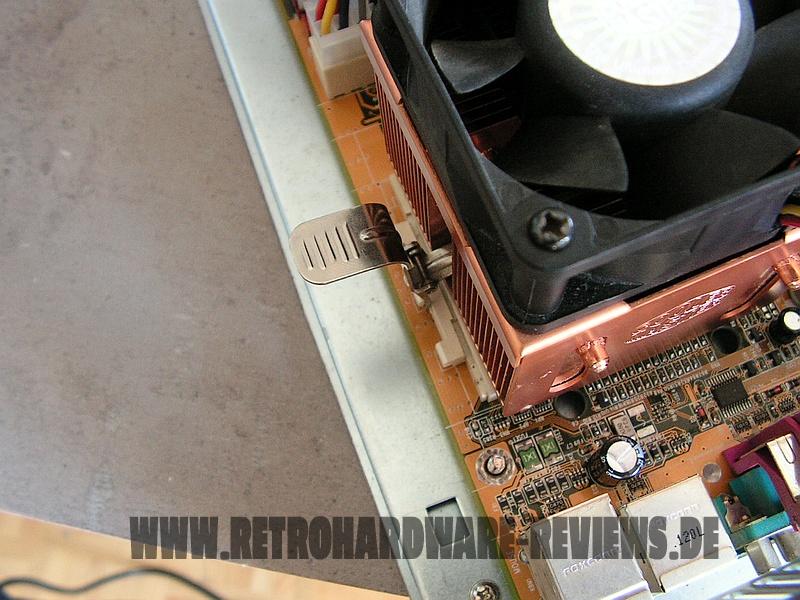


One little issue with the layout is, that no memory modules can be installed, when a long videocard like the 3dfx Voodoo 5 5500 is in the AGP slot, since it will block the levers of the memory slots. But again - this is a very small problem, many older cards like the Geforce 256 or many Geforce 2 models will not even interfere with the first memory slot. Additionally, the memory modules have to be installed beginning with DIMM4 - so even with a Geforce 4 Ti 4200 installed, you can still swap memory sticks, if you use just a single module.
Test-System and Parts
Baseline Setup:
- CPU: AMD Athlon Thunderbird 1200C (FSB133)
Because I want to compare 1st Gen Socket A mainboards to their DDR follow-ups I have to use a CPU, which is available in FSB100 and FSB133 versions with the same clockspeed. Since I sadly don't have a Thunderbird 1400 B at my disposal, I will use the Thunderbird 1200 for my reviews and comparisons of these boards, which I have in the “B” (FSB100) and “C” (FSB133) version.
- RAM: 1x Corsair CMX512-3200C2 (XMS3202v4.2) = 512MB PC400 CL2
This Corsair XMS stick should allow the tightest timings at 266 MHz DDR and its size of 512MB is the perfect choice for Windows 98SE.
- VGA: MSI Geforce 4 TI4200-VTD8X
To remove any GPU bottleneck for testing, I chose a Geforce 4 Ti as the primary graphics card for my test setups. The Geforce 4 Ti series are also known to pull a lot of power from the AGP port, so that possible problems in that department can also be revealed. It is also somewhat period correct and a good match for a high performance retro-machine that should be able to run late Windows 98SE games without any issues.
- VGA2: 3dfx Voodoo 5 5500 AGP
Many people consider the Voodoo 5 5500 the perfect card for (Win9x-) retro gaming. The Voodoo 5 benefits from a beefy setup, so a powerful Athlon Thunderbird or early Athlon XP is the perfect match for this card.
- Audio: Creative Soundblaster Live! (SB0060)
Creative's Soundblaster Live! can be found in many retro-machines. It offers great sound, perfect Win98SE compatibility and is still widely available for reasonable money. It was also known to cause problems with VIA-based 686B southbridges using old BIOS revisions and VIA chipset drivers. All this should be history at this point, but double checking on pontentially affected mainboards is still not a bad thing to do.
- LAN: 3Com Etherlink XL PCI
Just a good, reliable choice for networking. All legacy Windows versions all the way up from Win95 have built-in drivers for it, which is also a huge “plus”.
- HDD: Western Digital WD200BB (20GB 7200RPM)
No special intention behind this drive, it is just “there” and still works fine.
Additional Hardware for certain Tests:
- Silicon Image Sil3512 SATA Controller & Samsung PM871 128GB SSD
These two will help me measure the PCI bandwidth.
- Hitachi Deskstar T7K500 (500GB 7200RPM)
This drive will tell us, how big we can go with the onboard IDE connectors and how the performance is like.
- 2x Voodoo 2 12MB (SLI)
A pair of Voodoo 2s is a must have for any retro-machine, that doesn't feature a 3dfx card as the primary VGA solution. They offer compatibility to older Glide games and can be used with any more powerful primary graphics card. It is an important thing to know, how well these perform and if there are differences between all the available Socket A chipsets of that era or even between boards using the same chipset.
Drivers used:
- Chipset: AMD AGP Miniport 4.80 + VIA Hyperion 4in1 4.56v (without the AGP drivers)
- Geforce 4: nVidia Forceware 43.45
- Voodoo 5: Amigamerlin 2.9
- Voodoo 2: FastVoodoo 4.6
- SB Live!: Some driver from my archive, not shure 😉
- 3Com NIC: Windows 98SE preloaded driver
- SATA Controller: Some driver from my archive, not shure 😉
System Setup and Usage
The first thing I'd like to mention is not directly related to the tests I'm doing as part of my regular reviewing.
The Abit KG7-RAID is part of one of my retromachines, and recently I used this exact PC during one weekend of Oldschool-LAN goodness. I had some minor stability issues and decided to give it a recap, as I plan to use the system for some longer and I don't want to wait until the problems get worse.
The CPU that I use on this particular board is an Athlon XP 1900+ Palomino, and my KG7 has one pecularity that I have never experienced on any other board and that shouldn't be there in the first place: When using an Athlon XP CPU, you have to use Reg ECC memory and activate the “Correct+Scrub” option in the BIOS, otherwise there are errors in Memtest.
Since it ran fine with this configuration, I just took this as given and assumed this was because of a little degradation that the KG7 suffered over time. So - when the (minor) instabilities joined the picture, it was clear that I would do a full recap on it.
Interestingly enough, this did not solve the issue, but changed it (one could say: made it worse). Now, the system simply freezes during Memtest, when an Athlon XP is installed. And this is regardless of what memory is installed: unbuffered RAM, Reg ECC with or without error correction enabled - the behaviour is identical. As soon as an Athlon Thunderbird is installed, the board runs fine and without a single problem. I did not find anyone else with similar problems on the KG7(-RAID) when I googled for it, so usually, (supported) Athlon XPs should run fine.
To me this is not a big problem. I'll just put an Athlon Thunderbird 1400C into this system after testing (this is more than enough for the Voodoo 3 3000@3500 that lives in there) and call it a day. As long is it runs stable in this configuration, I am OK with that.
So - back to the regular part of the review:
Installation and configuration of CPU and memory is completety hassle-free on the KG7. CPU, as well as memory, are automatically configured to 100 MHz when a new CPU is installed and then you can configure everything as needed directly from within the BIOS. All the important settings like clocks, voltages and multiplier settings can be found in Abit's fantastic Softmenu III section.
What really makes the KG7 stand out, are the endless possibilities to tweak memory and chipset settings. Fortunately, you can - at least for the “SDRAM timing setting” - select from various profiles, which already configure 10 settings for the memory alone in one step. You can chose between Normal / Fast / Turbo and Ultra, as well as Auto, or you can adjust each setting by yourself when set to Manual.
With my Corsair XMS stick the KG7 runs the Ultra setting without a problem, even though it sets the (main) timings to CL2 2-2-4 (!). Under the Chipset Driving Control section, you have another 20+ settings to tweak chipset parameters, or just leave them at the Auto setting (which I did).
When it comes to the installation of the expansion cards, the setup was pretty straightforward. The Abit KG7-RAID has the same INT routing as the Abit KT7A-RAID (according to the manual), so I directly installed all expansion cards identical to the final configuration I used on Abit's KT133A board.
This resulted in the following setup:
- PCI #1: free
- PCI #2: Silicon Image Sil3512 SATA Controller
- PCI #3: Voodoo 2
- PCI #4: Voodoo 2
- PCI #5: Soundblaster Live!
- PCI #6: 3Com Etherlink XL PCI
With this constellation, I was able to complete all benchmarking without a problem.
Benchmarks
Synthetic Measurements
Before we get into the 3DMark and gaming benchmarks, let's have a look at some theoretical numbers. These synthetic tests will exhibit the differences between the several chipsets and boards better than any game benchmark and provide us with "background information" that might be of use in understanding the timedemo results later.
Memory Performance: AIDA64 Cache & Memory Benchmark

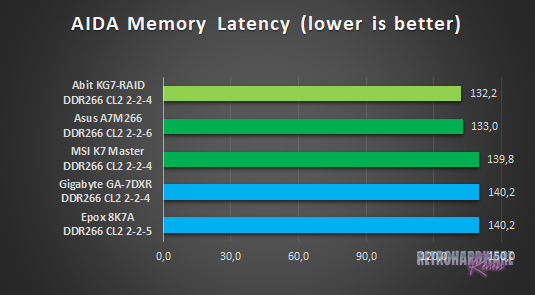
Abit's KG7-RAID shows an impressive performance in the memory bandwidth test, achieving the highest values for both read- and write throughput. It also has the lowest memory latency, with only the A7M266 being able to compete.
Application Performance: 7-Zip

Another first place for the KG7-RAID, which was to be expected from what we saw beforehand in the AIDA memory benchmarks.
AGP and PCI Performance: 3DMark 2000 and ATTO
3DMark 2000 as a whole is very focused on TnL and is by far not as interesting for retro-hardware comparisons as its predecessor. Its “High Polygon Count, 1 Light” test, however, is another good way to measure the AGP performance. In opposite to the Final Reality test, the general system performance is also somewhat of importance. The benchmark was executed with the Geforce 4 Ti installed.
To measure PCI performance, I installed a Windows 98SE compatible SATA controller with a Samsung PM871 128GB SSD connected into the system. For the bench, I chose 1024 to 4096 KB block size and picked the overall best values for the read and write throughput. This test will show, which maximum performance can be expected with fast storage options like SATA or SCSI and maybe gives a hint, if the chipset might be good for Voodoo 2 cards.
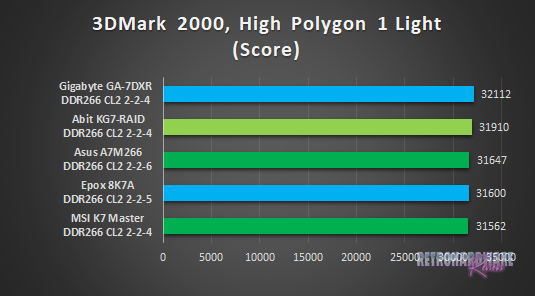

The Abit board ranks second in the 3DMark2000 sub-test, closely following the GA-7DXR. This is a very good result, considering the relatively low AGP bandwidth measured before. The strong overall system performance we saw in the other tests surely helped here.
It ranks last in the PCI bandwidth test, but the results are fairly close among all boards and the performance shown by all contenders, including the KG7-RAID, is top notch overall.
Storage Performance: HDTach
To measure the performance of the board's IDE and (if available) onboard IDE RAID solutions' performance, I benched one of the latest and fastest IDE drives (the Hitachi Deskstar T7K500 500GB) with the HDTach benchmark. I also tried a much more “recent” drive (the Western Digital Blue Edition 500GB), which should be even faster in theory, but the Hitachi drive produced much better results in this test.


Judging from the results, it seems like the KG7-RAID is limited to UDMA66, although the VIA southbridge provides an UDMA100 interface for IDE. But Abit is not alone with this, the boards of EpoX and Gigabyte show the same behaviour.
The performance of its Highpoint RAID chip is decent, giving the KG7-RAID one of the the overall fastest IDE-based storage options among the boards tested, (closely) second only to the GA-7DXR's Promise RAID solution.
Gaming Benchmarks
Now that we got all the theoretical performance numbers, let's see how the contenders perform in 3D gaming benchmarks.
3D Performance: 3DMark99max
3DMark99max was released in early 1999 and comes without support for Hardware TnL. The maximum supported (hardware-) DirectX level is DX6. It is a great benchmark to reveal good overall system performance, as it rewards good memory bandwidth and latency more than the slight clockspeed advantage, that some boards have because of their factory-overclocked FSBs.
- Version: "latest"
- Settings: standard
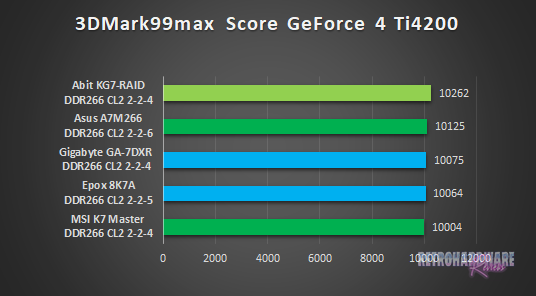

With more than a hundred points distance to the second-placed A7M266, the Abit board ranks first in the GeForce 4 Ti run of 3DMark99max. While this is a very good result already, the KG7-RAID's performance in the Voodoo 5 run are nothing short of astonishing. I don't know what kind of sorcery happens between Abit's board and the 3dfx card, but The KG7-RAID is lightyears ahead of the competition.
This reeks of human failure in the measurement, but I repeated the test and the result was perfectly reproducible (with little variation of course). I have seen a similar behaviour with another Abit board, the KT7A-RAID, but I honestly have no explanation for it. All I can say is, it's repeatable and the test looks normal (no graphical glitches or so).


The KG7-RAID delivers the highest performance in the Voodoo 2 SLI run as and also achieves the highest CPU score of all boards, making it the undisputed king of 3DMark99max. Let's see how the performance is like in actual gaming benchmarks.
3D Performance: Unreal Tournament (UT99) Timedemo(s)
Unreal Tournament (UT99) was released in November 1999 and is notorious for its hunger for CPU power. I chose to use two different timedemos for comparison, of which the utbench.dem timedemo is heavily CPU bound and therefore qualifies to measure the general performance of the boards. The second timedemo benchmark.dem is as GPU limited as possible in this game. This will reveal, how much impact a faster board can still have in more GPU limited situations. This game is also perfect to show, on which chipsets and boards Voodoo 2 cards run best.
- Version: 4.36
- Settings: High, Min desired Framerate "0", Show Decals [x], Use Dynamic Lightning [x]
- Geforce: D3D
- Voodoo 2 and Voodoo 5: Glide


We see very close results in the utbench timedemo. The Abit board ranks second in terms of average framerate, with higher minimum FPS than the leading A7M266.
In the second timedemo, the KG7-RAID is able to pull ahead of the competition noticeably. While the differences between rank two through four are very minor, Abit's board has an advantage of over 1 FPS in average framerate and more than 1,5 FPS in minimum framerate over the second-placed Asus A7M266.

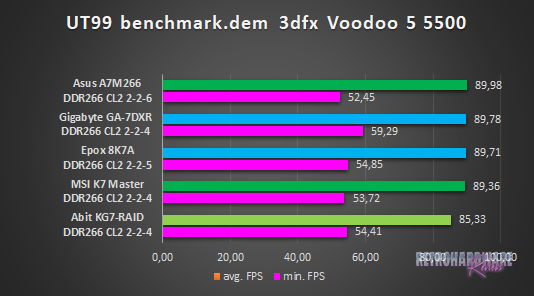
The KG7-RAID and the Asus A7M266 both are a tiny bit ahead of the competition in average and also minimum framerates in the Voodoo 5 run of the utbench timedemo. Both contestants perform basically identical with almost non-existant differences.
The board's result in the second timedemo comes unexpected, however, considering the stellar 3DMark99max performance with the Voodoo5 and the very strong results in UT with the nVidia card just seen before. While all the other boards achieve around 89 to 90 FPS on average here, the KG7-RAID tops out at just over 85 FPS. The minimum FPS look OK though, the Abit board ranks third in this respect.
Again, the outcome is repeatable, I never got more than 85.xx FPS on average with the Voodoo 5 installed in this timedemo.

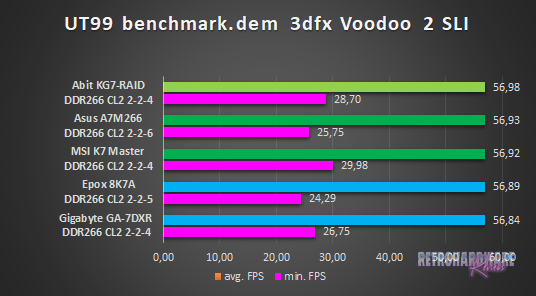
We see a return to strength for the Abit board in the Voodoo 2 SLI run of the UT timedemos. The KG7-RAID pushes out the highest average framerate, as well as the second best minimum FPS in both tests.
3D Performance: Quake III Arena Timedemo
Quake 3 Arena was released shortly after Unreal Tournament, in December of 1999. It is known to reward fast memory latency and with its normal preset, it is completely CPU limited; at least for the GeForce 4 and the Voodoo 5. The Voodoo 2 SLI cards clearly limit the Athlon 1200 here, as the timedemo will show.
- Version: 1.32
- Settings: “Normal” Preset, only resolution changed to 1024x768x16
- Geforce 5 and Voodoo5: OpenGL
- Voodoo 2: “Voodoo” Renderer (miniGL)


The KG7-RAID takes first place with the GeForce 4 installed, which is expected at this point, considering the excellent performance we saw before using the nVidia card, and the strong performance in the AIDA memory bandwidth and -latency tests.
But in the Voodoo 5 run of the timedemo, the Abit board shows issues again and achieves the lowest FPS of all boards. It almost seems, like there is a general problem of some kind on the KG7-RAID, if OpenGL or Glide is used in combination with the Voodoo 5.
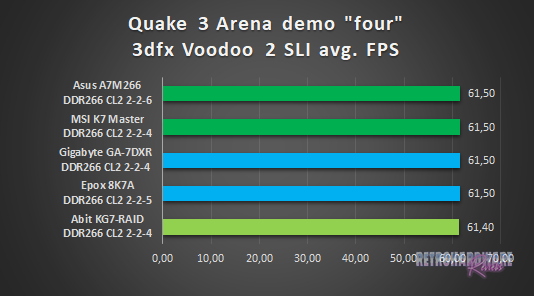
The Voodoo 2 SLI setup clearly limits here. All boards score the same FPS, with only the Abit KG7-RAID a close 0,1 FPS behind.
Summary & Rating
Abit KG7-RAID (AMD761)
-
Layout
-
Features
-
Overclocking Options
-
Compatibility
-
Documentation & Support
-
Performance: GeForce 4 Ti 4200
-
Performance: Voodoo 5 5500
-
Performance: Voodoo 2 SLI
OVERALL
| Pros | Cons |
| + Great layout | – CPU Support only average |
| + 4 memory slots & ECC support | |
| + Fantastic PCI performance | |
| + Fantastic BIOS |





